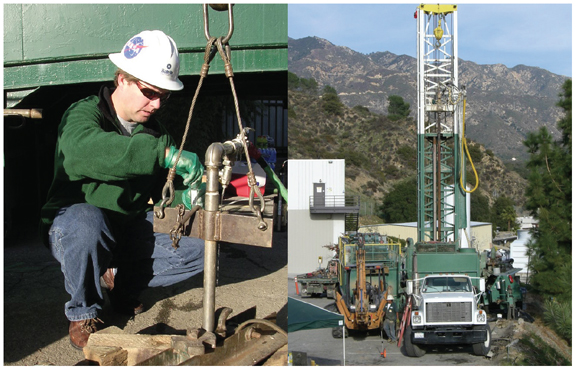
Baseline sampling performed during the groundwater cleanup at JPL.
By Mary O’KEEFE
The NASA groundwater cleanup near and adjacent to Jet Propulsion Laboratory has received final approval, referred to as the Record of Decision (ROD), from NASA and the regulatory agencies overseeing the project.
Steve Slaten, Facilities and Environmental manager at the NASA Management Office, has been working on the groundwater cleanup since he started at NASA – 15 years ago. The project had begun a few years before that.
“We think we will [be cleaning] for another 10 to 15 years,” he said.
The approval of the ROD represents a major step in the site cleanup process under the terms of the federal Comprehensive Environmental Response, Compensation and Liability Act (CERCLA), commonly known as Superfund, according to a NASA statement.
The groundwater cleanup was needed because of practices that took place decades ago, Slaten said.
JPL began in the early to mid-1930s when some Caltech students and rocket enthusiasts accidentally caused an explosion on campus. It was decided that it would be more advantageous if the group moved to a more isolated area for its experiments, like near the base of the San Gabriel Mountains where present- day JPL is located.
“Solvents were used all over [at the time],” Slaten said. “They were industrial degreasers that got into the deep groundwater.”
Before and after WWII, those working at JPL used common cleaning solvents.
“The groundwater chemicals being addressed by NASA are volatile organic compounds (VOCs) and the chemical compound perchlorate. These compounds were used during the 1940s and 1950s when liquid wastes used at JPL were disposed of in seepage pits. This practice was common at the time, but was discontinued at JPL in the late 1950s,” NASA stated in a release.
Those solvents contaminated the groundwater and affected JPL, the City of Pasadena and the Lincoln Avenue Water Company near Altadena.
“NASA put treatment plants on [three] wells so they can be used and safe clean water would be supplied,” Slaten said.
Although the cleanup continues, and reviews of the process will be done every five years, the ROD approval verifies the process is working.
The groundwater is important because it supplies about a third of the water for the area, Slaten said.
As is common at NASA/JPL, every process is a learning opportunity.
“We are always learning things and sharing [what we learn] is part of our jobs,” he said.
One of the things discovered was the use of a treatment in which naturally occurring bacteria was used to remove perchlorate. The project was also the first to use ion exchange, which replaces unwanted minerals in water with less objectionable ones. The project used ion exchange to remove perchlorate from water, as well as the other methods, and a report was written on the process.
Working together and sharing innovative techniques has not gone unnoticed by NASA. In 2017, Slaten won the NASA Blue Marble Award recognizing his “exceptional leadership” in implementing NASA’s vision while “protecting the home planet and improving the quality of life on Earth.” He was honored for his innovative solutions and his collaborative efforts regarding the groundwater cleanup. Slaten said he is proud of the accomplishments of NASA’s groundwater cleanup project and shares the success with the cooperative efforts of neighboring water suppliers like the Lincoln Avenue Water Company and the City of Pasadena.
